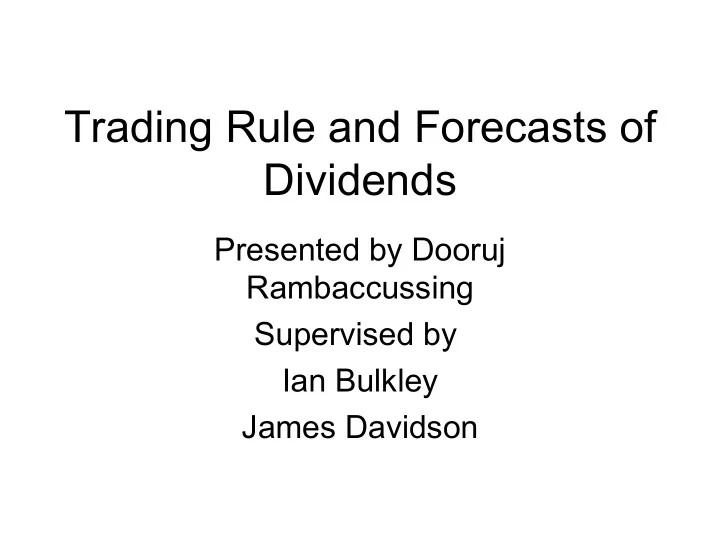

Trading Rule and Forecasts of Dividends Presented by Dooruj Rambaccussing Supervised by Ian Bulkley James Davidson
Introduction • Objective : ‘Can Econometric Forecasts of Dividends help in building up a trading rule for enhancing wealth ?’ Innovation of this paper : • Forecasting of Dividends (Brown et. al 2000) • Use of Fama and French (2002) Earnings and Dividend growth rate as the discount rate.
Background Literature • Trading Rule: (Bulkley and Tonks 1989, 1991), (Bulkley and Taylor 1996) • Models for forecasting(Timmermann 2008) • Forecast comparison (Hansen 2005)
Trading Rules -Moving Average Oscillator -Trading Break-Out - Comparison of REPV with Actual Price
REPV of Equity • Model 1: 1 P t r E t D t 1 • Model 2 1 P t r g E t D t 1 • Innovation: E t [D t+1 ] is proxied by one step ahead forecasts • 4 Empirical Valuations of r were used.
Trading Rule • Assumption of 2 assets (Equity and Bonds) • Compare REPV (P*) with Actual Price (P) • P*> P (Go long on Equity Index) • P*< P (Go long on Bonds)
Forecasting Accuracy • Hansen Superior Predictive Accuracy Test (Global) • Recursive Mean Squared Error Plots (Local)
Background for Forecasting D t+1 • S&P 500 • Sample: Jan 1871 to Aug 2008 • Initial Estimate January 1871 to Dec 1900 • Use Rolling and Recursive Windows • No formal misspecification test applied in sample –Objective is forecasting misspecification • 40 models were estimated (Window type, Functional form)
4 Best Models • Model 1: ln D t 1 i 1 p i ln D t 1 i t 1 • Model 2 D t 1 1 t 1 D t t 1 • Model 3 (Generic Form) F t 1 F t (1- D t 9 forms of this model is considered based on type of Trend and Seasonality. Best Model is selected using AIC.
Forecast Models (Continued) • Model 4 f t 1 D t 1 1 D t 2 P t 3 E t 4 R t
Results on Forecasting Accuracy • Hansen’s test - MAE: Rolling Exponential Smoothing (Model 3) -MSE: Recursive Exponential Smoothing (Model 3) • Unconditional MSE : • AR (p) (Model 1)
Recursive Mean Squared Error Plot Time Plot 0.08 Model 1 Rec Model 1 Rol 0.07 Model 2 Rec Model 2 Rol Model 3 Rec 0.06 Model 3 Rol Model 4 re 0.05 Model 4 Rol 0.04 0.03 0.02 0.01 0 01/1904 01/1916 01/1928 01/1940 01/1952 01/1964 01/1976 01/1988 01/2000
Benchmarks Annually compounded Return on S&P 500 is 5.96% 2008. $100 invested in January 1901 is worth $ 51 919 in 2008 Experiment: Invest $100 January 1901 and shift assets as dictated by trading rule
Accumulated Wealth Time Plot 4.5e+006 Model 1 Rec Model 1 Rol 4e+006 Model 2 rec Model 2 rol 3.5e+006 Model 3 Rec Model 3 Rol 3e+006 Model 4 Rec Model 4 Rol 2.5e+006 2e+006 1.5e+006 1e+006 500000 0 01/1904 01/1916 01/1928 01/1940 01/1952 01/1964 01/1976 01/1988 01/2000
Accumulated Wealth under Buy and Hold Buy and Hold 90000 80000 70000 60000 50000 40000 30000 20000 10000 0 01/1904 01/1916 01/1928 01/1940 01/1952 01/1964 01/1976 01/1988 01/2000
Major Findings and Conclusion • Out of 160 accumulated wealth values, the trading rule beats the accumulated wealth if invested on the stock market 111 times. • Fama and French (2002) discount rate model of Earnings Growth does not beat benchmark. • Strength of Rule : identifies timing when to shift Assets from Equity to Bonds and vice-versa. (and not necessarily the number of times going long on equity) • REPV of Stock is sensitive to the type of discount rate being used.
Recommend
More recommend